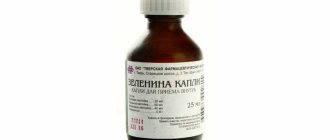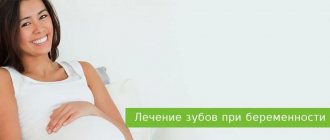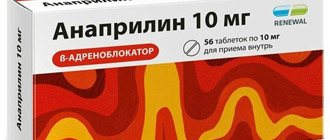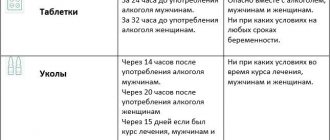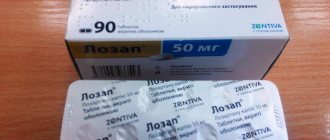In the case of chronic heart failure, as well as in stressful situations, physical and nervous exhaustion, myocardial cells and neurons often suffer. They experience oxygen starvation, which negatively affects metabolic processes. To treat and prevent these conditions, Eltacin tablets are used. They are popular among patients - more than 80% of reviews are positive.
Pharmacodynamics
Eltacin® is a combination drug that contains a mixture of non-essential amino acids: glycine, glutamic acid and cystine, which are metabolic regulators: increasing the intracellular concentration of glutathione and the activity of glutathione-dependent enzymes, normalizing redox processes and oxygen utilization in tissues, due to which the drug:
— exhibits antioxidant (reduces the content of free radicals, peroxide compounds, malondialdehyde) and antihypoxic (increases the body’s resistance to oxygen deficiency, enhancing the processes of ATP synthesis) effect;
— increases myocardial contractility;
- increases physical performance;
— improves the quality of life of patients with chronic heart failure (increases social adaptation, improving psycho-emotional state);
— accelerates the recovery of performance after intense physical activity in children.
Instructions
Composition/description
Registration number: LS-000499
Trade name: Eltacin®
Group name:
Glycine + Glutamic acid + Cystine.
Dosage form:
sublingual tablets.
Composition (per tablet):
active ingredients: glycine – 70 mg, glutamic acid – 70 mg, cystine – 70 mg; excipients: methylcellulose – 7.8 mg, magnesium stearate – 2.2 mg.
Description:
round biconvex tablets of white or white with a yellowish tint.
Pharmacotherapeutic group:
antioxidant agent.
ATX code:
C01EX.
Pharmacological properties
Pharmacodynamics:
Eltacin® is a combination drug that contains a mixture of non-essential amino acids: glycine, glutamic acid and cystine. The components of Eltacin® are metabolic regulators that increase the intracellular concentration of glutathione and the activity of glutathione-dependent enzymes, normalizing redox processes and oxygen utilization in tissues, due to which the drug:
- exhibits antioxidant (reducing the content of free radicals, peroxide compounds, malondialdehyde) and antihypoxic effects (increasing the body's resistance to oxygen deficiency, enhancing the synthesis of adenosine triphosphoric acid (ATP));
- increases myocardial contractility;
- increases physical performance;
- improves the quality of life of patients with chronic heart failure (increasing social adaptation, improving psycho-emotional state);
- accelerates recovery of performance after intense physical activity in children.
Pharmacokinetics:
glycine penetrates into most biological fluids and tissues of the body, incl. into the brain, does not accumulate in tissues, is metabolized to water and carbon dioxide. When taken, glutamic acid is well absorbed and penetrates the blood-brain barrier and cell membranes. It is utilized during metabolism, 4–7% is excreted unchanged by the kidneys. After administration, the concentration of cystine gradually increases, reaching a maximum after 30 minutes, and then slowly decreases. Cystine does not accumulate and is not toxic.
Indications for use
Autonomic dysfunction syndrome in adults and children over 12 years of age.
Prevention of chronic physical overstrain and recovery after intense physical activity during sports in children aged 11 to 15 years.
Chronic heart failure of functional class I–III according to the NYHA classification in adults (against the background of standard therapy).
Chronic heart failure of functional class I–II according to the NYHA classification in children over the age of 12 years (against the background of standard therapy).
Contraindications:
hypersensitivity to the drug, children under 11 years of age (efficacy and safety have not been established).
Precautions for use:
does not require special precautions.
Use during pregnancy and breastfeeding:
No separate studies have been conducted. Not recommended for use during pregnancy and breastfeeding.
Directions for use and doses
Sublingually. The tablet can also be chewed and held in the mouth under the tongue until completely dissolved.
Autonomic dysfunction syndrome in adults and children over 12 years of age: 1 tablet 3 times a day sublingually, course of treatment from 1 to 3 months depending on the severity of the disease, repeated courses are prescribed on the recommendation of a doctor.
Prevention of chronic physical overexertion in children aged 11 to 15 years: 1 tablet 2 times a day for 2–3 weeks.
During the recovery period after intense physical activity when playing sports in children aged 11 to 15 years: 1 tablet 3 times a day for 2 weeks.
Chronic heart failure of functional class I–III according to the NYHA classification in adults: 1 tablet 3 times a day sublingually, course of treatment from 1 to 3 months depending on the severity of the disease, repeated courses are prescribed on the recommendation of a doctor.
Chronic heart failure of functional class I–II according to the NYHA classification in children over 12 years of age: 1 tablet 3 times a day sublingually, course of treatment from 1 to 3 months depending on the severity of the disease, repeated courses are prescribed on the recommendation of a doctor.
Additional Information
Side effect.
Allergic reactions are possible.
Overdose.
No cases of overdose have been identified.
Interaction with other drugs.
Can be taken simultaneously with angiotensin-converting enzyme (ACE) inhibitors, beta-blockers, diuretics, aldosterone antagonists, organic nitrates and slow calcium channel blockers.
The possibility of the drug influencing the ability to drive vehicles and other potentially dangerous mechanisms:
does not affect.
Release form.
Sublingual tablets, 70 mg+70 mg+70 mg. 30 tablets in a blister pack made of polyvinyl chloride film and aluminum foil. 1 blister pack along with instructions for use in a cardboard pack.
Storage conditions:
at a temperature not exceeding 25 °C in the original packaging (blister packaging in a pack). Keep out of the reach of children.
Best before date.
3 years. Do not use after the expiration date indicated on the package.
Vacation conditions.
Available without a prescription.
Indications for the drug Eltacin®
chronic heart failure of functional class I–III according to the NYHA classification in adults (against the background of standard therapy);
chronic heart failure of functional class I–II according to the NYHA classification in children aged 12 to 18 years (against the background of standard therapy);
autonomic dysfunction syndrome in children aged 12 to 18 years;
prevention of chronic physical overstrain and recovery after intense physical activity when playing sports in children aged 11 to 15 years.
"Eltacin": description of the drug
The drug is available in tablet form. The active ingredient is a complex of amino acids:
- L-cystine;
- glycine;
- L-glutamic acid.
They ensure normal metabolism in the tissues of the heart muscle (myocardium), due to which the cells are well saturated with oxygen. This serves to prevent the risk of hypoxia (oxygen starvation).
Glycine actively influences the regulation of metabolic processes. It also affects brain cells and improves memory, attention and other mental functions. Taking this substance helps relieve emotional stress and increased tension in muscle fibers.
L-glutamic acid ensures the normal course of metabolic processes in the nervous and humoral (endocrine) systems. It helps reduce the stress response when hypoxia occurs. Its effect is similar to glycine - the component also improves brain function. It also acts as a hepatoprotector.
Cystine starts metabolic processes and stimulates the restoration of damaged cells in tissues. Accelerates the elimination of harmful substances and toxins. It also works as a powerful antioxidant - it blocks free radicals that destroy cells.
Directions for use and doses
Sublingual. The tablet can also be chewed and held in the mouth under the tongue until completely dissolved.
CHF I–III functional class according to the NYHA classification in adults; CHF functional class I–II according to the NYHA classification in children aged 12 to 18 years; autonomic dysfunction syndrome in children aged 12 to 18 years: 1 table. 3 times a day, the course of treatment is from 1 to 3 months, depending on the severity of the disease, repeated courses are prescribed on the recommendation of a doctor.
Prevention of chronic physical overexertion in children aged 11 to 15 years: 1 table. 2 times a day for 2–3 weeks.
During the recovery period after intense physical activity when playing sports, children aged 11 to 15 years - 1 table. 3 times a day for 2 weeks.
"Eltacin": indications and contraindications
Most often, tablets are taken for chronic heart failure. They are also indicated for use in the following cases:
- mental, physical exhaustion (not only in adults, but also in children);
- deviations in the behavior of children and adolescents;
- ischemic stroke;
- delayed mental development (also in children);
- recovery period after severe pathologies and operations;
- dysfunction of the autonomic nervous system;
- emotional overstrain, stress (exams, work);
- increased nervous excitability, irritability;
- unstable emotional state;
- sleep problems.
There are few contraindications - the drug can be taken even during pregnancy and breastfeeding. However, there are also contraindications:
- hypersensitivity, allergic reactions;
- children up to 11 years old inclusive.
Reviews about Eltatsin
The drug has a diverse effect - mainly on the central nervous system and autonomic system , as well as on metabolic processes in the myocardium . The body's defense systems against stress are directly related to the amino acid glycine , which has a stress-protective effect, improves memory and attention, and reduces psycho-emotional stress. Glutamic acid increases resistance to hypoxia , improves oxygen transport to tissues and its rational use.
Cystine is considered as a detoxifier and antioxidant . In general, the drug is considered as an antioxidant . The use of Eltacin is indicated for many diseases and conditions, but reviews more often contain information about its use for functional disorders of the autonomic nervous system in adults and children. All patients who left reviews are satisfied with its effect - they note its effectiveness, low price and the absence of adverse reactions.
- “... My daughter was prescribed for VSD and took it for about two months. Everything got better: sleep was restored, my hands stopped getting cold, the headaches stopped.”
- “... The remedy is really good, it was prescribed for a 10-year-old child for VSD.”
- “... The drug coped with our problem - our daughter is in adolescence and has a constant decline in mood or outbursts of emotions with scandals, weakness and headache.”
- “...Took my 14-year-old daughter, they are very effective for VSD: headaches and mood swings disappeared. I thought it was a transitional age, but it turned out to be a disease.”
- “...Very good and safe tablets. They were prescribed to my 13-year-old son and he took it for 1.5 months. Weakness, headaches and decreased attention went away. I began to do well in my studies. I'm glad".
- “... The drug is great - I took it for 2 months, the fatigue, hysterics and irritability, constant headaches in the evening went away.”
Eltacin's analogs
Level 4 ATX code matches:
Validol
Tonginal
Tricardin
Instenon
Pumpan
Barboval
Corvalment
Antioxidant agents - Mexidol , Emoxibel , Emoxipin , Neurox.
